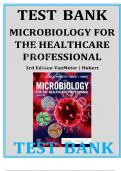TEST BANK
MICROBIOLOGY FOR
THE HEALTHCARE
PROFESSIONAL
3rd Edition VanMeter | Hubert
TEST BANK
, Microbiology for the Healthcare Professional 3rd Edition Test Bank
Table of Contents
Section 1: Basic Science
Chapter 1. Scope of Microbiology
Chapter 2. Chemistry of Life
Chapter 3. Cell Structure and Function
Chapter 4. Bacteria and Archaea
Chapter 5. Viruses
Chapter 6. Eukaryotic Microorganisms
Section 2: Tools for Study and Control of Microorganisms
Chapter 7. Physical and Chemical Methods of Control
Chapter 8. Microbiological Laboratory Techniques
Chapter 9. Microbiological Laboratory Safety Issues
Chapter 10. Pharmacology
Chapter 11. Antimicrobial Drugs
Section 3: Infection, Disease, and Defense
Chapter 12. Infection and Disease
Chapter 13. The Immune Response and Lymphatic System
Section 4: Effects on Specific Body Systems
Chapter 14. Infections of the Integumentary System, Soft Tissue and Musculoskeletal System
Chapter 15. Infections of the Respiratory System
Chapter 16. Infections of the Gastrointestinal System
Chapter 17. Infections of the Nervous System and Sensory Structures
Chapter 18. Infections of the Cardiovascular and Circulatory Systems
Chapter 19. Infections of the Urinary System
Chapter 20. Infections of the Reproductive System
Section 5: Factors Contributing to the Effects of Microorganisms on Human Health
Chapter 21. Sexually Transmitted Infections/Diseases
Chapter 22. Human Age and Infections
Chapter 23. Microorganisms in the Environment and Effects on Human Health
Chapter 24. Emerging Infectious Diseases
Chapter 25. Biotechnology
,Chapter 01: Scope of Microbiology
VanMeter: Microbiology for the Healthcare Professional, 3rd Edition
MULTIPLE CHOICE
1. In the sixteenth century a father-and-son team, by the name of , produced a
compound microscope consisting of a simple tube with lenses at each end.
a. van Leeuwenhoek
b. Semmelweis
c. Janssen
d. Hooke
ANS: C REF: p. 3
2. “Animalcules” were first described by
a. Robert Hooke.
b. Antony van Leeuwenhoek.
c. Hans Janssen.
d. John Needham.
ANS: B REF: p. 3
3. Micrographia, a publication illustrating insects, sponges, as well as plant cells, was published
by
a. Robert Hooke.
b. Antony van Leeuwenhoek.
c. Hans Janssen.
d. John Needham.
ANS: A REF: p. 3
4. Low-Power Microscopes designed for observing fairly large objects such as insects or worms
are?
a. electron microscopes.
b. dark-field microscopes.
c. fluorescence microscopes.
d. stereomicroscopes.
ANS: D REF: p. 5
5. A microscope that provides a three-dimensional image of a specimen is a
a. dark-field microscope.
b. transmission electron microscope.
c. bright-field microscope.
d. scanning electron microscope.
ANS: D REF: p. 7
6. The tool of choice to observe living micro-organisms is the
a. bright-field microscope.
b. phase-contrast microscope.
, Microbiology for the Healthcare Professional 3rd Edition VanMeter Test Bank
Ultimatestudyguide2021@gmail.com
c. fluorescence microscope.
d. electron microscope.
ANS: B REF: p. 6
7. Which scientist is most responsible for ending the controversy about spontaneous generation?
a. John Needham
b. Joseph Lister
c. Louis Pasteur
d. Robert Koch
ANS: C REF: p. 8
8. Fossils of prokaryotes go back billion years.
a. 4.0 to 5.0
b. 3.5 to 4.0
c. 2.5 to 3.0
d. 2.2 to 2.7
ANS: B REF: p. 9
9. Molds belong to which of the following groups of eukaryotic organisms?
a. Protozoans
b. Archaea
c. Fungi
d. Algae
ANS: C REF: p. 11
10. The correct descending order of taxonomic categories is
a. species, domain, phylum, kingdom, order, division, class, genus.
b. domain, kingdom, phylum, class, family, order, genus, species.
c. domain, kingdom, phylum, class, order, family, genus, species.
d. kingdom, domain, phylum, order, class, family, genus, species.
ANS: C REF: p. 10
11. Complex communities of microorganisms on surfaces are called
a. colonies.
b. biofilms.
c. biospheres.
d. flora.
ANS: B REF: p. 12
12. A relationship between organisms in which the waste product of one provides nutrients for
another is called
a. mutualism.
b. competition.
c. synergism.
d. commensalism.
ANS: D REF: p. 12




